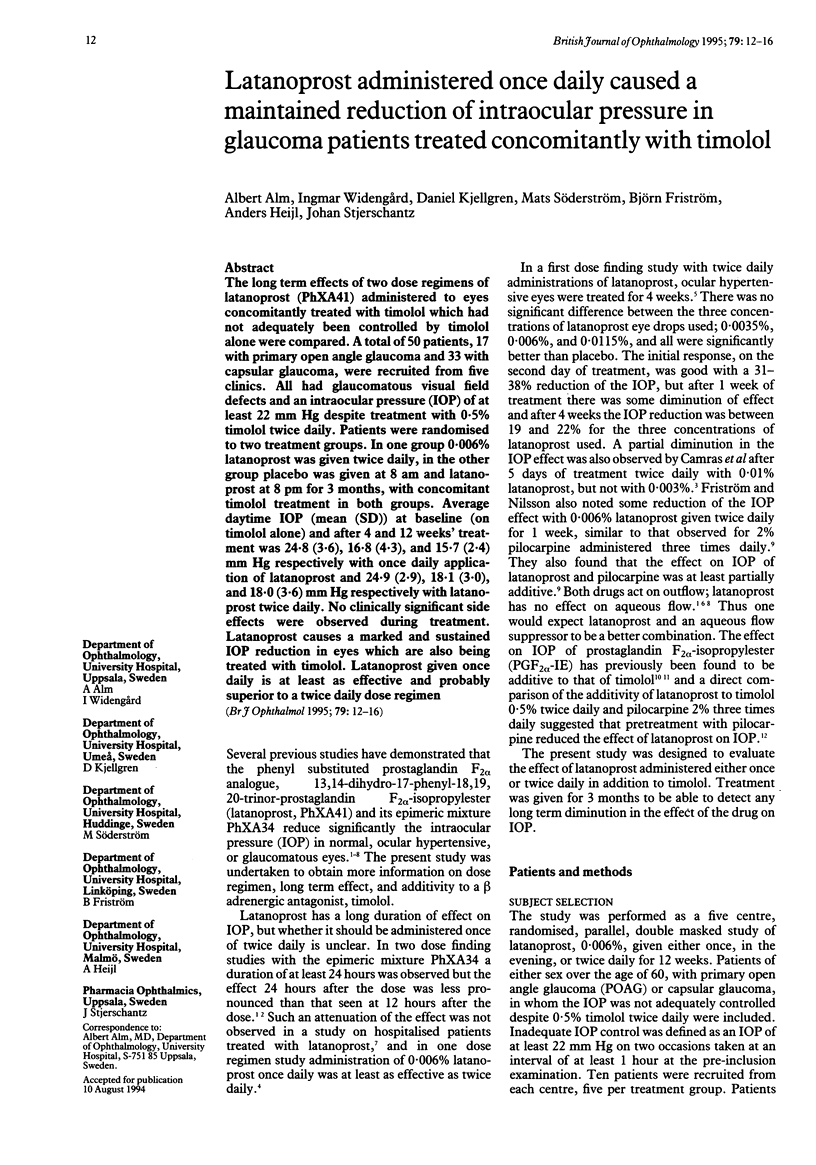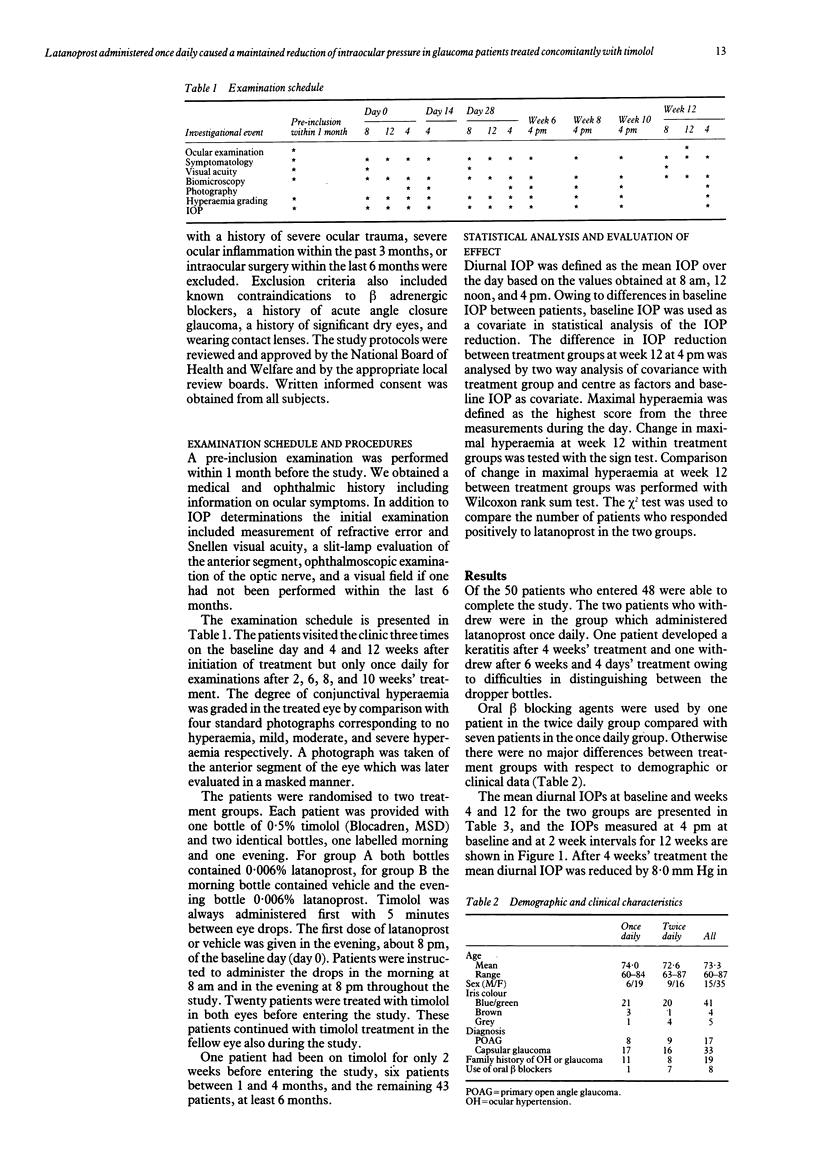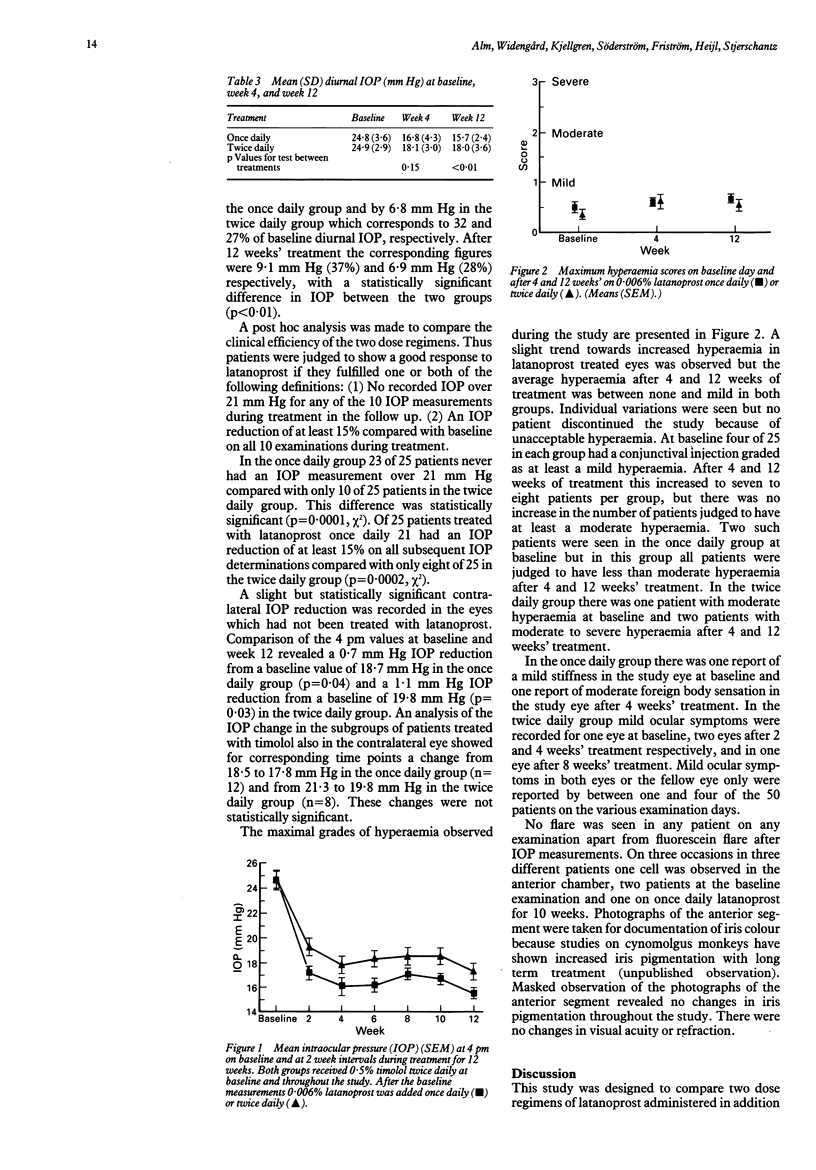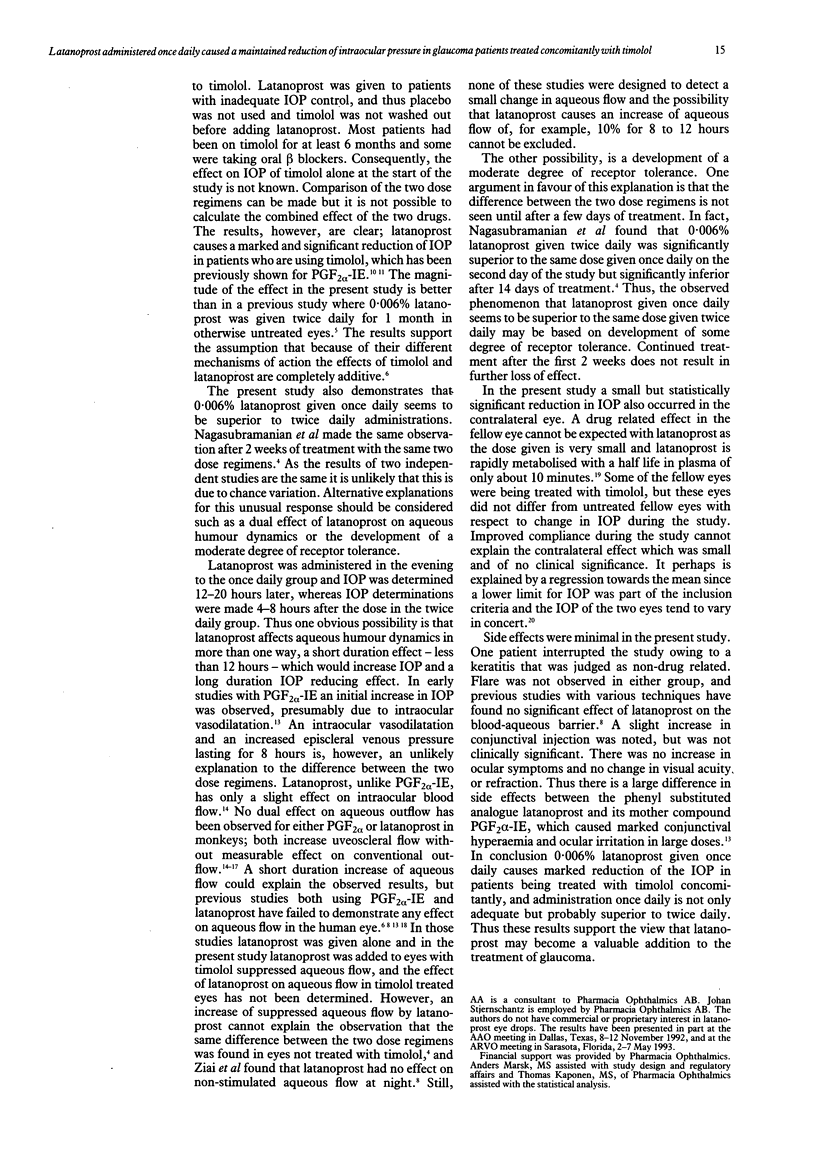Abstract
The long term effects of two dose regimens of latanoprost (PhXA41) administered to eyes concomitantly treated with timolol which had not adequately been controlled by timolol alone were compared. A total of 50 patients, 17 with primary open angle glaucoma and 33 with capsular glaucoma, were recruited from five clinics. All had glaucomatous visual field defects and an intraocular pressure (IOP) of at least 22 mm Hg despite treatment with 0.5% timolol twice daily. Patients were randomised to two treatment groups. In one group 0.006% latanoprost was given twice daily, in the other group placebo was given at 8 am and latanoprost at 8 pm for 3 months, with concomitant timolol treatment in both groups. Average daytime IOP (mean (SD)) at baseline (on timolol alone) and after 4 and 12 weeks' treatment was 24.8 (3.6), 16.8 (4.3), and 15.7 (2.4) mm Hg respectively with once daily application of latanoprost and 24.9 (2.9), 18.1 (3.0), and 18.0 (3.6) mm Hg respectively with latanoprost twice daily. No clinically significant side effects were observed during treatment. Latanoprost causes a marked and sustained IOP reduction in eyes which are also being treated with timolol. Latanoprost given once daily is at least as effective and probably superior to a twice daily dose regimen.
Full text
PDF




Selected References
These references are in PubMed. This may not be the complete list of references from this article.
- Alm A., Villumsen J. PhXA34, a new potent ocular hypotensive drug. A study on dose-response relationship and on aqueous humor dynamics in healthy volunteers. Arch Ophthalmol. 1991 Nov;109(11):1564–1568. doi: 10.1001/archopht.1991.01080110100045. [DOI] [PubMed] [Google Scholar]
- Alm A., Villumsen J., Törnquist P., Mandahl A., Airaksinen J., Tuulonen A., Marsk A., Resul B., Stjernschantz J. Intraocular pressure-reducing effect of PhXA41 in patients with increased eye pressure. A one-month study. Ophthalmology. 1993 Sep;100(9):1312–1317. doi: 10.1016/s0161-6420(93)31482-x. [DOI] [PubMed] [Google Scholar]
- Camras C. B., Schumer R. A., Marsk A., Lustgarten J. S., Serle J. B., Stjernschantz J., Bito L. Z., Podos S. M. Intraocular pressure reduction with PhXA34, a new prostaglandin analogue, in patients with ocular hypertension. Arch Ophthalmol. 1992 Dec;110(12):1733–1738. doi: 10.1001/archopht.1992.01080240073034. [DOI] [PubMed] [Google Scholar]
- Friström B., Nilsson S. E. Interaction of PhXA41, a new prostaglandin analogue, with pilocarpine. A study on patients with elevated intraocular pressure. Arch Ophthalmol. 1993 May;111(5):662–665. doi: 10.1001/archopht.1993.01090050096037. [DOI] [PubMed] [Google Scholar]
- Gabelt B. T., Kaufman P. L. Prostaglandin F2 alpha increases uveoscleral outflow in the cynomolgus monkey. Exp Eye Res. 1989 Sep;49(3):389–402. doi: 10.1016/0014-4835(89)90049-3. [DOI] [PubMed] [Google Scholar]
- Gabelt B. T., Kaufman P. L. The effect of prostaglandin F2 alpha on trabecular outflow facility in cynomolgus monkeys. Exp Eye Res. 1990 Jul;51(1):87–91. doi: 10.1016/0014-4835(90)90174-s. [DOI] [PubMed] [Google Scholar]
- Kerstetter J. R., Brubaker R. F., Wilson S. E., Kullerstrand L. J. Prostaglandin F2 alpha-1-isopropylester lowers intraocular pressure without decreasing aqueous humor flow. Am J Ophthalmol. 1988 Jan 15;105(1):30–34. doi: 10.1016/0002-9394(88)90117-1. [DOI] [PubMed] [Google Scholar]
- Lee P. Y., Shao H., Camras C. B., Podos S. M. Additivity of prostaglandin F2 alpha-1-isopropyl ester to timolol in glaucoma patients. Ophthalmology. 1991 Jul;98(7):1079–1082. doi: 10.1016/s0161-6420(91)32173-0. [DOI] [PubMed] [Google Scholar]
- Nagasubramanian S., Sheth G. P., Hitchings R. A., Stjernschantz J. Intraocular pressure-reducing effect of PhXA41 in ocular hypertension. Comparison of dose regimens. Ophthalmology. 1993 Sep;100(9):1305–1311. doi: 10.1016/s0161-6420(13)31817-x. [DOI] [PubMed] [Google Scholar]
- Nilsson S. F., Samuelsson M., Bill A., Stjernschantz J. Increased uveoscleral outflow as a possible mechanism of ocular hypotension caused by prostaglandin F2 alpha-1-isopropylester in the cynomolgus monkey. Exp Eye Res. 1989 May;48(5):707–716. doi: 10.1016/0014-4835(89)90011-0. [DOI] [PubMed] [Google Scholar]
- Rácz P., Ruzsonyi M. R., Nagy Z. T., Bito L. Z. Maintained intraocular pressure reduction with once-a-day application of a new prostaglandin F2 alpha analogue (PhXA41). An in-hospital, placebo-controlled study. Arch Ophthalmol. 1993 May;111(5):657–661. doi: 10.1001/archopht.1993.01090050091036. [DOI] [PubMed] [Google Scholar]
- Toris C. B., Camras C. B., Yablonski M. E. Effects of PhXA41, a new prostaglandin F2 alpha analog, on aqueous humor dynamics in human eyes. Ophthalmology. 1993 Sep;100(9):1297–1304. doi: 10.1016/s0161-6420(93)31484-3. [DOI] [PubMed] [Google Scholar]
- Villumsen J., Alm A. PhXA34--a prostaglandin F2 alpha analogue. Effect on intraocular pressure in patients with ocular hypertension. Br J Ophthalmol. 1992 Apr;76(4):214–217. doi: 10.1136/bjo.76.4.214. [DOI] [PMC free article] [PubMed] [Google Scholar]
- Villumsen J., Alm A. Prostaglandin F2 alpha-isopropylester eye drops: effects in normal human eyes. Br J Ophthalmol. 1989 Jun;73(6):419–426. doi: 10.1136/bjo.73.6.419. [DOI] [PMC free article] [PubMed] [Google Scholar]
- Villumsen J., Alm A. The effect of adding prostaglandin F2 alpha-isopropylester to timolol in patients with open angle glaucoma. Arch Ophthalmol. 1990 Aug;108(8):1102–1105. doi: 10.1001/archopht.1990.01070100058034. [DOI] [PubMed] [Google Scholar]
- Ziai N., Dolan J. W., Kacere R. D., Brubaker R. F. The effects on aqueous dynamics of PhXA41, a new prostaglandin F2 alpha analogue, after topical application in normal and ocular hypertensive human eyes. Arch Ophthalmol. 1993 Oct;111(10):1351–1358. doi: 10.1001/archopht.1993.01090100059027. [DOI] [PubMed] [Google Scholar]


